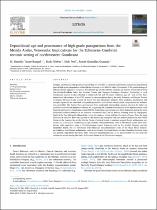| dc.contributor.author | Tazzo-Rangel, MD | |
| dc.contributor.author | Weber, B | |
| dc.contributor.author | Frei, D | |
| dc.contributor.author | González-Guzmán, R | |
| dc.date.accessioned | 2022-07-27T16:36:14Z | |
| dc.date.available | 2022-07-27T16:36:14Z | |
| dc.date.issued | 2021 | |
| dc.identifier.citation | Tazzo-Rangel, M. Daniela & Weber, Bodo & Frei, Dirk & González-Guzmán, Reneé. (2021). Depositional age and provenance of high-grade paragneisses from the Mérida Andes, Venezuela: Implications for the Ediacaran–Cambrian tectonic setting of northwestern Gondwana. Lithos. 404-405. 106436. 10.1016/j.lithos.2021.106436. | en_US |
| dc.identifier.issn | 0024-4937 | |
| dc.identifier.uri | http://www.journals.elsevier.com/lithos/ | |
| dc.identifier.uri | http://hdl.handle.net/10566/7641 | |
| dc.description.abstract | Isotopic, geochemical, and geochronological data are provided to constrain sedimentary sources and depositional ages of high-grade paragneisses of the Iglesias Complex in the Mérida Andes (Venezuela). U-Pb geochronology of detrital zircons suggests a maximum depositional age of 540–530 Ma, whereas age spectra reveal sources from Pan-African-Brasiliano belts, the Amazon Craton, and Oaxaquia-Putumayo basement. Reworking of such Gondwanan sources is also reflected in whole-rock Nd and Hf crustal residence ages of ~2.0–1.3 Ga. Post-depositional disturbance of the U-Pb system by metamorphism during the early Paleozoic and Permo–Triassic is assessed through in-situ analysis of zircon rims and discordant analyses. Field evidence, geochemical and isotopic signatures are consistent with pelitic-psammitic and volcanic-volcaniclastic compositions for sedimentary protoliths. The former show provenances from continental intermediate sources, whereas the latter are probably sourced in an immature volcanic arc, suggesting the initiation of subduction of the Iapetus oceanic crust beneath northwestern Gondwana around 530 Ma. Sedimentary precursors were likely deposited during the latest Ediacaran–earliest Cambrian in an extensive continental shelf, fed by detritus draining from the topographic highs of the Pan-African-Brasiliano belts, across the Amazon craton and into the Iapetus Ocean. Thus, the main direction of sediment flow was opposite to the present-day transport from the Andes Cordillera by the Pacific Ocean to the Amazon fan in the Atlantic Ocean. Chemical trends in gneisses suggest fluvial sedimentary protoliths and cold-climate weathering at high latitudes. Metasedimentary rocks in the Mérida Andes show similarities with equivalent units in Peri-Gondwanan crustal fragments such as the Acatlán Complex and the Santander Massif, but no correlation with Ediacaran metasedimentary rocks of the Maya Block. Ediacaran–Cambrian fossiliferous sedimentary rocks in the Eastern Venezuela Basin and the Colombian foreland basin are possible equivalents but these units remained unmetamorphosed, as its paleoposition was far from the subduction trench during the Early Ordovician climax of the Famatinian orogeny. © 2021 Elsevier B.V. | en_US |
| dc.language.iso | en | en_US |
| dc.publisher | Elsevier | en_US |
| dc.subject | Detrital zircon | en_US |
| dc.subject | High-grade paragneiss | en_US |
| dc.subject | Iglesias Complex | en_US |
| dc.subject | Nd–Hf isotope systematics | en_US |
| dc.subject | Sediment provenance | en_US |
| dc.title | Depositional age and provenance of high-grade paragneisses from the Mérida Andes, Venezuela: Implications for the Ediacaran–Cambrian tectonic setting of northwestern Gondwana | en_US |
| dc.type | Article | en_US |

